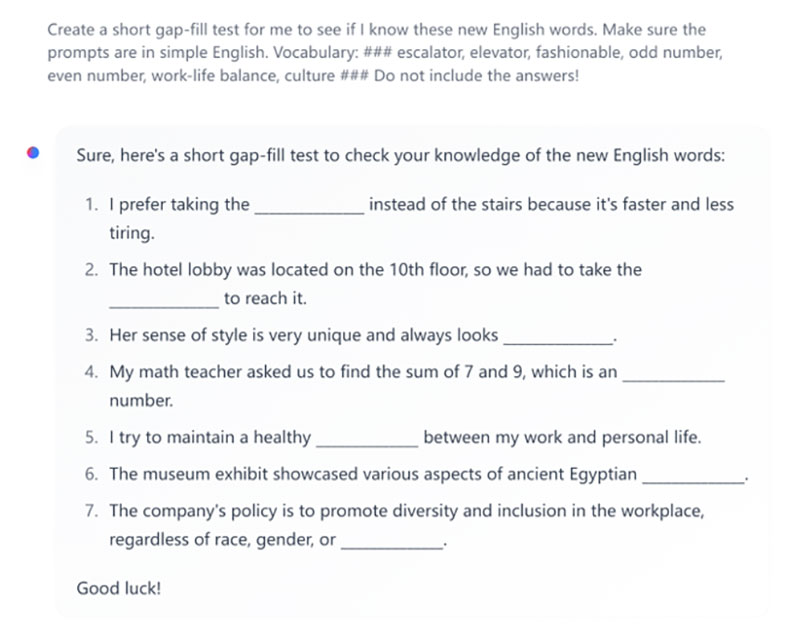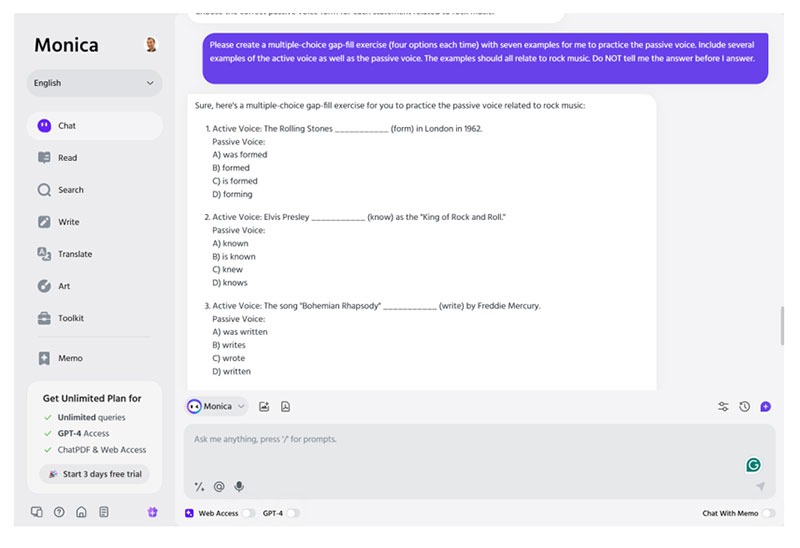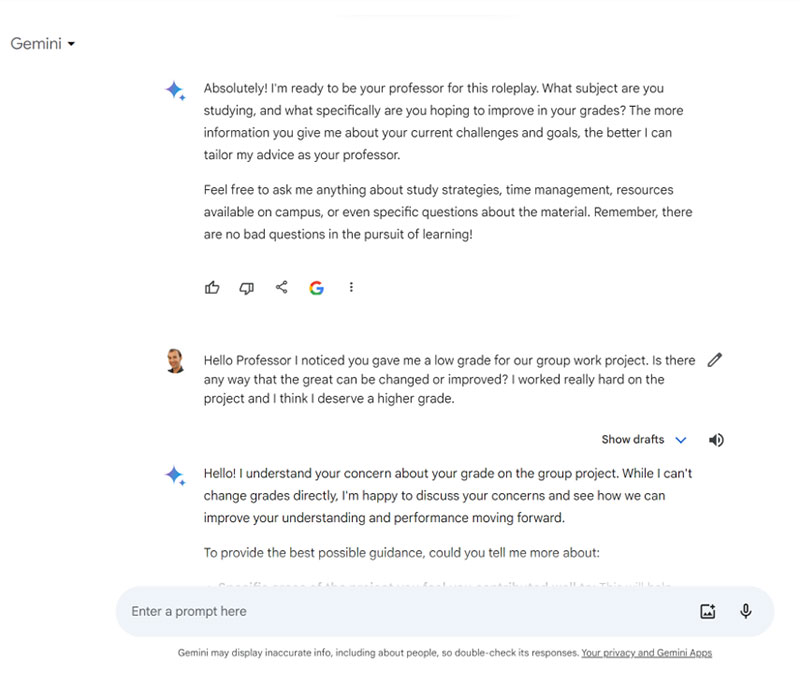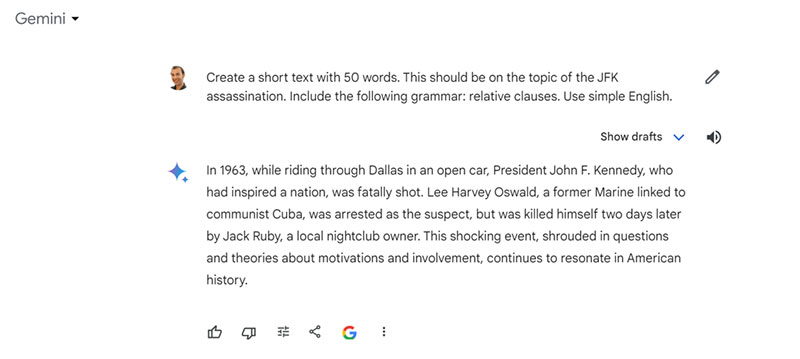18th March 2024
“How can I stop my students using AI or ChatGPT for homework?” That was the one question I was bombarded with in 2023. It’s understandable that teachers are, or were, worried about AI. Every time a disruptive new technology comes along, there is a fear that some students will use it to gain an unfair advantage. Over time, things change. No one today would expect their students to research something by visiting their local library instead of using the internet. It’s highly unlikely any teachers would ask their students to handwrite an essay instead of using a word processor. And, in time, most teachers will expect and encourage their students to use AI in their homework.
We’re not there yet, but in this blog post we’ll look at taking the first steps towards this future. We’ll look at the potential that AI has to benefit learning outside the classroom, as well as the drawbacks. I’ll share with you some simple ideas for AI-assisted homework tasks. I’ll end the post by discussing what you need to consider before assigning your first AI homework task.
AI Adoption
Unlike a lot of other tech, adoption of AI in education isn’t being driven by governments, schools, or even teachers. It’s being driven by students. It doesn’t matter whether you think AI is the best thing since sliced bread or an evil apparatus that will destroy education. Your students are already using it. There are only two options for educators. Allow students to use AI however they want or teach students how to use AI responsibly. To show you what I mean, let’s look at a couple of examples. As you read, think about which of these is more beneficial for learning.
Example 1: A primary school student gets an assignment to research a topic and write a few paragraphs about it. She starts by brainstorming. Then, she asks Chat GPT to add more ideas. She chooses the best, and fact checks them using a variety of websites. Then, she writes her essay. After completing a draft, she shows it to Chat GPT and requests feedback. She edits the assignment based on the AI’s comments, and hands it in.
Example 2: Another primary school student gets an assignment to research something and write a few paragraphs about it. She spends ten minutes crafting a prompt to ask Chat GPT to write the essay for her. She asks the AI to use short simple sentences that look like they could have been written by a nine-year-old. She then copies the answer onto paper, to make it look like she wrote it herself. She then hands the assignment in.
I would say that more learning is happening in example 1 than example 2.
In example 1, the student:
- practices brainstorming
- uses critical thinking to select ideas
- sorts ideas into paragraphs
- practices typing
- asks for feedback
- and edits a draft.
That’s quite a lot of learning. The learning is different to what we’re used to, but it is still learning.
In example 2, the learning is lower level. The student practices handwriting, but not much else apart from crafting a prompt. These were probably not the skills that her teacher wanted her to practice when the homework assignment was set.
You might be thinking, “What about Example 3, where the student doesn’t use AI?” Sorry, that doesn’t exist anymore. Your students are already using AI. And if they aren’t, then they will be soon.
Why Set AI-Powered Homework?
Let’s look at some of the reasons why you should encourage your students to use AI outside of class.
- Independence. For years educators have banged on about learner autonomy. Has there been a better tool for self-directed learning than AI?
- Preparing for work. Learning to use AI prepares students for education and working environments that will increasingly rely on this technology. Not being able to use AI in 2035 will be like not knowing how to use the internet in 2005.
- Equality. Traditional homework activities can widen inequalities between students. Learners who get assistance at home get ahead of their classmates who can’t get help. But now, if you can access AI outside the classroom, you stand a better chance of keeping up with your more privileged peers.
- Feedback. AI allows students to get customised support. AI can provide personalised assessments, recommendations, and coaching. Teachers can do this too, but unlike teachers, AI doesn’t need days off and is happy to help at 11pm the night before a deadline.
- Preparation. With the flipped classroom, students get input at home before practicing in class. AI takes this a step further. Language learners can now practice having a conversation at home with AI. This allows students to build confidence in a safe space free from judgment before speaking in front of their teacher and classmates.
AI-Integrated Homework Activities
Next, we’re going to look at homework activities that encourage students to use AI.
Essay Writing
Students can use AI to help write an essay. As we saw earlier, leaving students to their own devices can mean they get AI to write their essay for them. Instead, using the following activities (in order), either together or separately to encourage students to use AI, without it taking over.
- Brainstorming: Students can use text-to-text AI like Chat GPT to brainstorm ideas and generate a topic outline. Students can select their favorite AI-produced ideas and add their own. Encourage students to generate ideas with more than one AI (e.g. Bard, Claude, Chat GPT and Hugging Chat). This will add complexity to the selection process.
- Fact-checking: Get learners to conduct research using AI-powered search engines like Perplexity. Perplexity helps users find information from the internet. Students can use hyperlinks to read the information in its original context. Fact-checking can also be done using web searches.
- Overcome writers' block: It isn’t unusual to work on an essay and struggle with some areas. Students can use text-to-text AI to fill in blanks left by writer’s block. They can then edit these to make them fit their own writing style.
- Feedback: Encourage students to use analytics tools like Hemmingway Editor to measure their essay's readability. Students can rewrite difficult to read sections to make them clearer. Students can also use text-to-text AI, like Claude to generate feedback on an essay. This can be general feedback or feedback based on the grading criteria from the school.
- Read aloud: Read aloud: Students can listen to their writing being read aloud using text-to-speech AI, like Natural Readers. This can help find any awkward phrasing or unclear sentences. This also makes typos, misspellings, and missing words stand out.
Personalised Assignments
With AI, homework doesn’t need to be one-size-fits-all anymore. Each of the following activities gets students to practice the same thing in a slightly different way. This allows for assignments to be personalised to students’ interests and to their ability level.
- Vocabulary in Context
Students can use AI to test them on using new vocabulary in context. In a traditional assignment, every student would be tested on the same words. AI lets every student choose the list of words they get tested on. Stronger students can choose harder lexis, weaker students can choose easier words, and everyone can add vocabulary which they are personally interested in. Students start by asking a text-to-text AI to create a short passage which includes words they want to be tested on. The AI can create two versions: one that is complete, and one with missing words. Students then fill in the blanks.

Personalised vocabulary test from HuggingChat
- Interactive Grammar Practice
Students can create their own exercises to help them practice grammar they learned in class. Students can change the question types they generate depending on the type of question they want to answer. As grammar can be used to talk about different topics, students can ask AI to create questions on subjects which are interesting to them. After a first-attempt, students can ask AI to repeat but with harder or easier examples depending on how well they did in the previous round.

Personalised grammar practice on the passive voice from Monica
- Interactive Accuracy Practice
To take this a step further, students can try using new grammar accurately in sentences and ask AI for feedback on this. If they make mistakes, they can try again and improve based on the feedback from AI. This allows students to experiment with new grammar outside of class without worrying about being wrong.
- Conversation Role Play
Using a plugin, ChatGPT and Gemini can both simulate a spoken conversation. While this may not be as authentic as talking to a teacher or a classmate, it allows students extra practice outside of the classroom without the anxiety that some students feel when speaking in class. ChatGPT does not get frustrated when waiting for a response. It does not make students feel bad when they make a mistake. And it doesn’t correct you unless you ask it to.

Conversation role play with Gemini
- Personalised Dictation
Students can create their own dictation exercises for homework. Unlike regular dictations, students can choose the topic of the audio that they will listen to. The language for the dictation can include specific grammar or vocabulary from class. Students can create the text using an AI text generator, before copying and pasting this into a text-to-speech AI, like Natural Readers. They can further personalise the dictation by choosing an accent and selecting the speed of speech.

Personalised Dictation from Google Gemini
Principles for Using AI with Homework Assignments
Before changing the homework that you have planned for your next class, consider the following principles for making AI part of your homework tasks.
- Start small. Introduce AI gradually into homework rather than changing all your assignments at once. This lets teachers, students, and parents to get comfortable with the technology. Begin by using AI for simple tasks like checking grammar or vocabulary.
- Compliance. Before asking students to use any AI tools, check with the school administration. They may have suggested AI applications which adhere to privacy regulations, safeguarding students' information. Check the policies before setting assignments.
- Readiness. Before asking students to use AI in a homework assignment, demonstrate in class how to use the technology. Prepare students by giving them some simple but useful prompts which can allow them to access useful feedback or other information.
- Transparency. Communicate to students, parents and school administrators why you have made AI part of your homework assignments. Make sure that everyone knows which tools students will be using, and what is expected of them in terms of engagement and critical thinking.
- Monitoring. Check that students are using AI responsibly in their homework. Encourage parents of younger students to become part of the process, monitoring students’ AI use at home.
- Critical thinking. Ensure that your students do not treat AI outputs as infallible. Push students to critically evaluate the content generated by AI tools. Set the expectation that learners might spend less time typing, but more time fact-checking.
- Engagement. Ask students to use AI tools that make learning enjoyable and interactive. This should encourage students to actively participate in their homework.
- Accessibility. Ensure that the AI applications chosen are user-friendly and accessible to all students. If some of your learners cannot access AI at home, find out where they can. If some of your students cannot access AI anywhere, include a non-AI homework option.
- Reflection. After students have used AI to assist with homework, set aside time in class for reflection on this. Ask students to share how they used AI, what they learned from the process and what they might do differently next time. This will encourage shared learning and more thoughtful use of AI in the future.
- Get better. Continuously assess how effective AI is in homework assignments. Ask for feedback from students, parents, and colleagues to find areas for improvement. Refine your activities and makes sure that AI integration improves learning outcomes over time.
Conclusions
AI is rapidly entering the mainstream for students of all ages. As educators, we cannot squeeze the toothpaste back in the tube. Students are already adopting AI for unsupervised learning beyond our classroom walls. Rather than an outright ban, the solution lies in setting clear policies and adapting assignments for the AI age. Teachers must guide students to use AI responsibly and ethically, designing activities that encourage critical thinking over blind AI reliance. Homework needs to change to take advantage of AI's strengths - personalization, interactivity, rapid feedback and creativity. With the right prompts, the right preparation and the right attitude, AI can revolutionise homework and expand opportunities for learning. Our students are already using AI. If we wait, students’ habits, good or bad, will become engrained. If we ban AI entirely, our learners will fall behind their peers. The first step is changing the question. Not, “How can I stop my students using AI for homework?” but “How can I get my students to start using AI for homework?”



